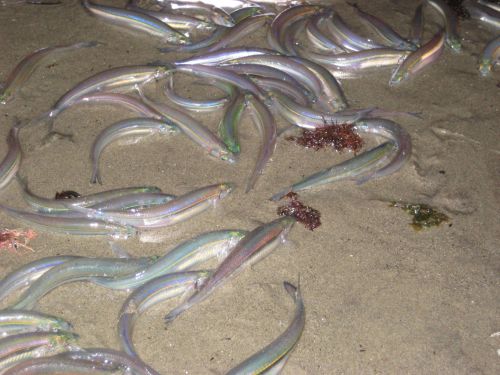About California Grunion
 Grunion (Leuresthes tenuis). CDFW sketch by P. B. Johnson.
Grunion (Leuresthes tenuis). CDFW sketch by P. B. Johnson.
 Grunion spawning on a Southern California beach.
Grunion spawning on a Southern California beach.
CDFW photo
Natural History
The California grunion (Leuresthes tenuis) is a member of the New World silversides family, Atheriniopsidae, along with jacksmelt and topsmelt. Their usual range extends from Point Conception, California, to Point Abreojos, Baja California. Occasionally, they are found farther north, to Monterey Bay, California, and south to San Juanico Bay, Baja California. They inhabit the nearshore waters from the surf to a depth of 60 ft. Tagging studies indicate that they do not migrate.
Grunion are the object of a unique recreational fishery. These fish are famous for their remarkable spawning behavior, which evokes an “I don’t believe it!” response from people seeing or hearing about it for the first time.
Grunion leave the water at night to spawn on beaches during the spring and summer months. For four consecutive nights, beginning on the nights of the full and new moons, spawning occurs after high tides and continues for several hours. As waves break on the beach, grunion swim as far up the slope as possible. The female arches her body and excavates the semi-fluid sand with her tail to create a nest. She twists her body and digs into the sand until she is half buried, with her head sticking up. She then deposits her eggs in the nest. Males curve around the female and release milt. The milt flows down the female's body until it reaches and fertilizes the eggs. As many as eight males may fertilize the eggs in a single nest. After spawning, the males immediately retreat toward the water while the female twists free and returns with the next wave. While spawning may only take 30 seconds, some fish remain stranded on the beach for several minutes.
Spawning occurs from March through August, and occasionally in February and September. Peak spawning is late March to early June.
Mature grunion may spawn during successive runs, with females spawning up to six times each season. Females lay between 1,600 and 3,600 eggs during one spawn, with larger females producing more eggs.
Eggs are deposited during the highest tides of the month and incubate in the sand during the lower tides, when they will not be disturbed by wave action. The eggs are kept moist by residual water in the sand. They hatch about 10 days later, during the next high tide series, when they are inundated with sea water and agitated by rising surf.
Most grunion seen on southern California beaches are between 5 and 6 in. long, with some are as long as 7 in. An average one-year old male is 4½ in. long while a female the same age is slightly larger at 5 in. Grunion mature and spawn at the end of the first year. At the end of two years, males average 5½ in. and females are around 5¾ in. long. By the end of three years, an average male is nearly 6 in. and a female is a little over 6¼ inches in length. Few live for more than three years.
Grunion food habits are not well known. They have no teeth, so they are presumed to feed on very small organisms. Shore birds, isopods, flies, sand worms, and beetles eat grunion eggs, while humans, larger fish, and other animals prey upon grunion.
Despite local concentrations, grunion are not abundant. The most critical problem facing the grunion resource is the loss of spawning habitat caused by beach erosion, harbor construction, and pollution. By the 1920s, the fishery was showing definite signs of depletion. A regulation was passed in 1927 establishing a closed season of three months, from April through June. The fishery improved, and in 1947 the closure was shortened to April through May. In 2022, the closure was again extended from April through June to better protect grunion during their peak spawning period, and a bag and possession limit of 30 fish was established.
During the open season, a fishing license is required for persons 16 years and older to capture grunion. Grunion may be taken by sport fishermen using hands only. No holes may be dug in the beach to entrap them. The daily bag and possession limit during the open season is currently 30 grunion.
To help conserve grunion populations, it is better to observe and learn rather than to hunt and collect. If you enjoy watching the mating ritual of grunion, please do not disturb the females depositing eggs tail first in the sand or the incubating eggs they leave behind. This will allow the grunion to complete the spawning portion of their life cycle and contribute to future grunion spawning events. The females do not die after spawning. In fact, they can spawn several times during a 4-day spawning event, and spawn in multiple events every year during their 3- to 4-year life span.
While grunion spawn on many beaches in southern California, CDFW does not recommend any particular beach because of changing safety conditions and local curfews. One of the best ways to find out which beaches have had recent runs is to call the state and county beach lifeguards who can often tell if spawning has taken place.
Cabrillo Beach Grunion Program
The Cabrillo Marine Aquarium(opens in new tab) offers a grunion program to the public a few nights of the season at Cabrillo Beach in San Pedro.
The Amazing Grunion
"The Amazing Grunion" article was originally printed in 1971 as Marine Resources Leaflet No. 3 by Jerome Spratt. This online version was updated in 2022.